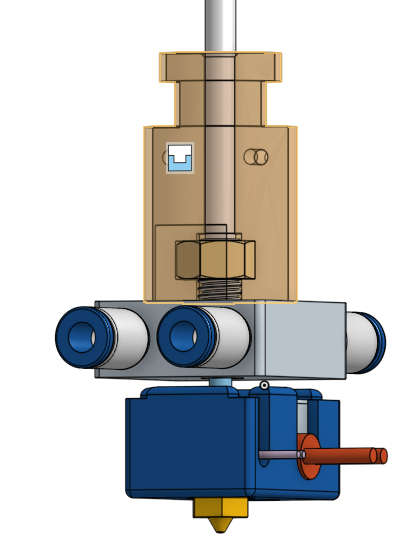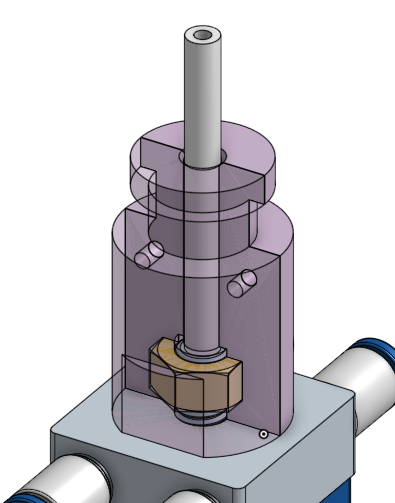Mosquito vs water cooling
-
@jens55 said in Mosquito vs water cooling:
As mentioned in the original post, I seem to have a heat creep issue when printing two materials.
Ian has that pretty good explained on his blog and also here in this thread. The heat will travel trough the filament, not much you can do about that except push filament forward. Could be interesting to test cooling with chiller and not just room temp water if dropping heatbreak to 4-5C would change anything (make it crack or actually stop the heat creep who knows
 )
)This is a chimera (clone) setup with two Volcano (clone) heat blocks.
I had a chance to compare kraken from e3d and kraken from bigtree (or it was the green.. / blue .. don't remember, but "reputable" PRC 3d printing part seller/manufacturer) and well "huuuuuuge" difference. I never saw chimera in person but I think it uses the same heatbreak as kraken right? when you plug the input hole on the heatsink and on the output of the heatbreak and try to push it in the heatsink it refuses to go in, behaves like a syringe, the fit is super precise/tight. On the other hand, the PRC one had at least half a mm play so heat transfer on the PRC ona was way worse. It can probbly be improved with some copper tape and heat greese but.. So what I'm trying to say, did you try measuring the temperatures on the heatbreaks, how cold can that heatsink keep them?
I did some experiments back in the day when I was planning to make a multi nozzle water cooled hotend by using a "very small heater block" (actually no block at all, I machined aluminium nozzle and wrapped the glass insulated khantal wire) - this gave very small thermal mass but with a very strong heater (150W). This way a part cooling fan would cool the nozzle quickly and strong heater would heat it up super quick so you could just turn the hotend off when you stop printing. It worked "ok-ish" but I had so many issues machining it (my lathe is not very good), aluminium is not a very good material for the nozzle (the orifice was waring off even with non abrasive materials) and it was very unsafe as 150W can easily melt that aluminium nozzle if anything bad happens, and since bad things did happen (luckily I never let it alone as I did not trust it so it was always monitored) I decided not to persue that path... but something like that could be done properly. Anyways imo the only "dual material" system that works is 2 separate extruders, I seen it done in different ways, 2 separate X motors, same Y rail etc etc.. you move the idle tool out of the way, you push a little bit of filament trough every now and then, have a nice string removal when engaging and that works ... check out BCN3D for e.g. (never tried those but first google result when I looked for that type of printer with dual heads)
-
@deckingman said in Mosquito vs water cooling:
But I still have no idea how I could join a 6 input cold block to 6 input hot block with short heat breaks sections between the two.
I don't think there is an easy solution.
@fma is right about the heatsink though.Wrote a long reply, then had an idea.
Have the cooling channels intersect the holes for the heatbreaks, but also cut o-ring retaining features inside the heatbreak holes and use o-rings to seal top and bottom. Leave some clearance in those holes, let the water act as your thermal interface. At that point your heatsink is mostly to just keep the water in.
You are already CNC'ing the parts, an internal o-ring groove isn't a big jump and the right size o-ring should give you a watertight seal. Assembly might be a pain, but it might work.
Might want to double up the o-rings for safeties sake... -
I am doing testing this morning and the heatsink (chimera clone) is hovering around 40C with both extruders running. This is looking pretty good to me. I am currently running a test model that alternates between materials and I have not run into my previous issue.
The issue before was that a single material was running for about 45 minutes before the second material came into play .... but thinking about it, it shouldn't (in theory) have caused issues because the standby temperature was pretty low.
I also have a lot of material extruded during the time when one extruder goes to standby and the other extruder warms up (the 0.4 mm nozzle extrudes a string about 100 mm long !!!). I have yet to come up with a good way of getting that crap out of the way. In any which case, I do an extra prime with a nozzle switch to replenish this material and this was the point when the system had issues. This morning I reduced the feed speed from 15 mm/sec to 5 mm/sec during this extra prime phase and there is a good possibility that the speed caused the extruder to wear a divot into the filament and then subsequently not feed right.
So far my test print is running fine and I am feeling optimistic about things. -
I've been using Mosquito's for about a year and have also been lucky enough to purchase a Mosquito Magnum Liquid and can offer some experience with heat creep with regard to the OP's question.
First, yes the Mosquito does have less heat creep than a typical v6 heat break. So much less, that the small fan provided with the Mosquito combo is sufficient when not in a heated enclosure. My enclosure is only 65c and I was having severe consistency and clogging issues with the OEM fan. I've tried 40mm fans which are still not enough. I believe the Mosquito design relies heavily on the ambient temperature for cooling and the cooling fins are not large enough when a mosquito is used in an enclosure.
That being said, they have changed the cooling fins (available on their site now) on the heat break. Not sure how the updated design works as I have the original version.
My current project is to test the Mosquito Magnum Liquid. I think this will be perfect for use in my enclosure and should resolve the occasional inconsistencies and clogs. I've never designed a cooling loop so learning about galvanic corrosion, reservoirs, fittings, fluid types, flushing, and all that. Eventually, the cooling loop will be expanded or a second loop added to cool the steppers. Should be a fun project and hopefully help improve consistency.
-
The Mosquito Magnum Liquid sounds like a wonderful addition! As I eventually want to go with a heated enclosure, I will look into this water cooled version.
-
@theruttmeister said in Mosquito vs water cooling:
...............You are already CNC'ing the parts......................
No I'm not. My small milling machine and lathe are completely manual (but fitted with DROs). I have to produce 2D dimensioned drawings on paper for everything I make.
-
Ah.
O-ring recesses in a hole is going to be a bit difficult then... maybe a press-fit plastic seal might be possible though. -
@theruttmeister how about some (silicone) glue instead of o-rings to make it water tight?
-
In an enclosure, a watercooling is the best solution for me. A chimera might very large for a single extruder. I drilled some blocks of aluminium used with the e3d heatbreak.
No more heatcreap with a very small block

All the parts in the watercooling are in aluminium
The first block had a thermistor in it and the mesured temperature remains at 27deg in a 60deg enclosure.
These blocks were made with a drill. -
@tech-raton I am having a bit of a problem visualizing what you have done there. I see the heater and you say you use the E3D heat break so I am assuming that the heat break screws into your cooling block ? I am not sure what the red thing is in the square aluminum tube. How does the filament get guided to the heat break during a filament change ? What is the path of the coolant in that block - is it simply a blind hole at the entrance and exit with a cross drilled path connecting the two blind holes that is then plugged with the bolt shown in the middle of the block side ?
-
Here is what I planned to do for a friend:

The heatbreak is not the standard one, it is a full M6 thread, instead of the standard M6/M7 one.
-
@jens55 said in Mosquito vs water cooling:
@tech-raton I am not sure what the red thing is in the square aluminum tube.
A remote extruder, I think.
@tech-raton, what is the hotend, on the delta? I like round the heat block... Is it a piezo, above the water cooling block?
-
@fma said in Mosquito vs water cooling:
Herre is what I planned to do for a friend:

The heatbreak is not the standard one, it is a full M6 thread, instead of the standard M6/M7 one.
OK so the water cooling block is a straight through drill and then a loop on the far side back into the cooler ? The ptfe tube goes straight to the heat break ? I assume the top thing is the ptfe coupling ?
Is the nut captive somehow in the assembly ? How ?
Sorry about all the questions ....
-
Yup the red thing is a remote extruder.
The watercooling on the corexy is just a 8mm aluminium part with 7 holes drilled
A m7 for the heatbreak
2 m5 for the pushfits
A m4 to connect the 2 m5 holes
3 m3 holes to attach on the carriageOn the delta, the hotend is a maxiwatt with a homemade silicon sock
And yes with a piezo as z probeWhy you heat
-
Thanks for the clarification!
-
Why have 4 pushfits?
You could make a u shape inside your watercooling.
It will reduce the flow but will increase the heat exchange. -
@jens55 said in Mosquito vs water cooling:
OK so the water cooling block is a straight through drill and then a loop on the far side back into the cooler ?
Exactly.
The ptfe tube goes straight to the heat break ?
Yes.
I assume the top thing is the ptfe coupling ?
No, this is the standard groove for hotends. It is designed for direct extruding. But you can modify this part (3D-printed) for Bowden, using a coupler thread.
Is the nut captive somehow in the assembly ? How ?
The 3D-printed part is made in 2 parts (split along the vertical axis), and glued together (there are 2 holes to help aligning it. Here is a closer view:

Sorry about all the questions ....
You welcome! This design hasn't beed tested, and I would love to have feedback if you go that way.
-
@tech-raton said in Mosquito vs water cooling:
Why have 4 pushfits?
Easier to do.
You could make a u shape inside your watercooling.
How? I only have a drill...
It will reduce the flow but will increase the heat exchange.
It is the same, as I use a small external tube to make the half turn.
-
@tech-raton said in Mosquito vs water cooling:
On the delta, the hotend is a maxiwatt with a homemade silicon sock
Thanks! I'll have a look at this block...
-
Ahh, clever! If the ptfe tube is captured by clamping pressure that seems to make clearing a clog kinda tough ???